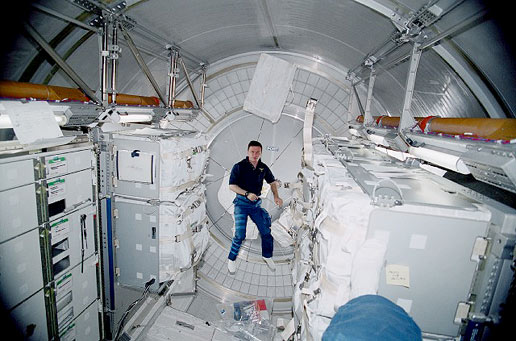Multi-Purpose Logistics Modules

Cosmonaut Yuri Gidzenko floats inside Leonardo, the first MPLM to deliver supplies to the Station. Credit: NASA.
The Multi-Purpose Logistics Modules, or MPLMs, of which there were three, are pressurized modules, built by the Italian Space Agency, that serve as the International Space Station's 'moving vans,' carrying equipment, experiments and supplies to and from the Station aboard the Space Shuttle.
The unpiloted, reusable MPLM functions as both a cargo carrier and a Space Station module. Mounted in the Space Shuttle's cargo bay for launch and landing, it is berthed to the Station using the Shuttle's robotic arm after the Shuttle has docked. While berthed to the Station, racks and equipment are unloaded from the module and then old racks and equipment may be reloaded to be taken back to Earth.
The Logistics Module is then detached from the Station and positioned back into the Shuttle's cargo bay for the trip home. When in the cargo bay, the module is independent of the Shuttle cabin, and there is no passageway for Shuttle crewmembers to travel from the Shuttle cabin to the module.
In order to function as an attached Station module as well as a cargo transport, the MPLM also includes components that provide some life support, fire detection and suppression, electrical distribution and computer functions. Eventually, the modules also will carry refrigerator freezers for transporting experiment samples and food to and from the Station.
Although built in Italy, the logistics modules are owned by the US and provided in exchange for Italian access to U.S. research time on the Station.
Module deliveries
Construction of the Leonardo module began in April 1996 at the Alenia Aerospazio factory in Turin, Italy. Leonardo was delivered to Kennedy Space Center from Italy in August 1998 by a special Beluga cargo aircraft. Raffaello arrived at Kennedy in August 1999. The third module, named Donatello, was delivered to Kennedy on 1 February 2001.
The cylindrical module is approximately 21 feet long and 15 feet in diameter, weighing almost 4.5 tons. It can carry up to 10 tons of cargo packed into 16 standard Space Station equipment racks. Of the 16 racks the module can carry, five can be furnished with power, data and fluid to support a refrigerator freezer.
Module names
The Italian Space Agency chose the names of the modules because they denote some of the great talents in Italian history:
• Leonardo da Vinci, an extraordinary inventor-scientist, civil engineer, architect, artist and military planner and weapons designer
• Donato di Niccolo Di Betto Bardi, one of the greatest sculptors of all time and one of the founders of modern sculpture
• Raffaello Sanzio, an artist whose work stands alone for its visual achievement of human grandeur, both in clarity of form and ease of composition.


